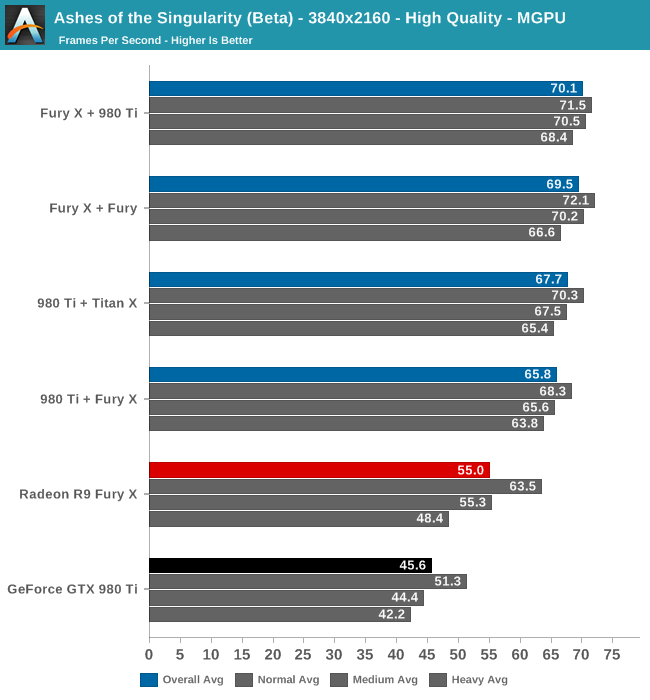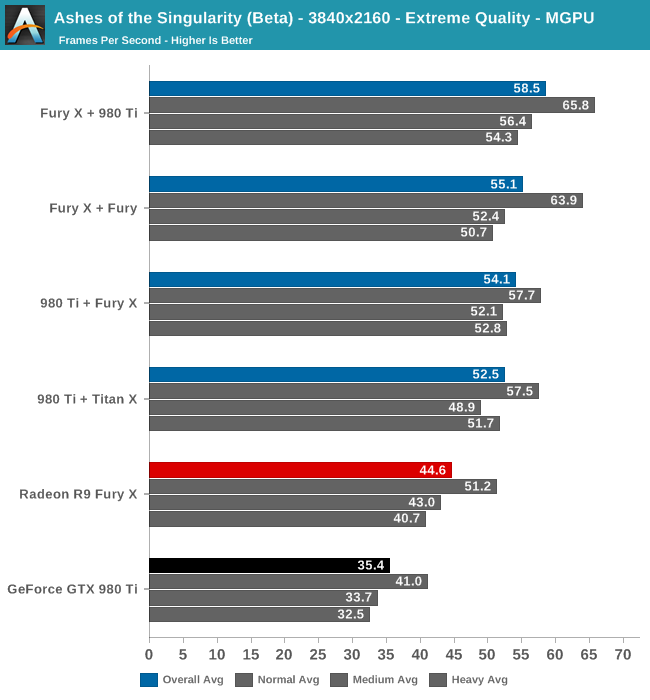Ashes of the Singularity Revisited: A Beta Look at DirectX 12 & Asynchronous Shading
by Daniel Williams & Ryan Smith on February 24, 2016 1:00 PM ESTDirectX 12 Multi-GPU Performance
Shifting gears, let’s take a look at multi-GPU performance on the latest Ashes beta. The focus of our previous article, Ashes’ support for DX12 explicit multi-GPU makes it the first game to support the ability to pair up RTG and NVIDIA GPUs in an AFR setup. Like traditional same-vendor AFR configurations, Ashes’ AFR setup works best when both GPUs are similar in performance, so although this technology does allow for some unusual cross-vendor comparisons, it does not (yet) benefit from pairing up GPUs that widely differ in performance, such as a last-generation video card with a current-generation video card. None the less, running a Radeon and a GeForce card together is an interesting sight, if only for the sheer audacity of it.
Meanwhile as a result of the significant performance optimizations between the last beta build and this latest build, this has also had an equally significant knock-on effect on mutli-GPU performance as compared to the last time we looked at the game.

Even at 4K a pair of GPUs ends up being almost too much at Ashes’ High quality setting. All four multi-GPU configurations are over 60fps, with the fastest Fury X + 980 Ti configuration nudging past 70fps. Meanwhile the lead over our two fastest single-GPU configurations is not especially great, particularly compared to the Fury X, with the Fury X + 980 Ti configuration only coming in 15fps (27%) faster than a single GPU. The all-NVIDIA comparison does fare better in this regard, but only because of GTX 980 Ti’s lower initial performance.
Digging deeper, what we find is that even at 4K we’re actually CPU limited according to the benchmark data. Across all four multi-GPU configurations, our hex-core overclocked Core i7-4960X can only setup frames at roughly 70fps, versus 100fps+ for a single-GPU configuration.

Top: Fury X. Bottom: Fury X + 980 Ti
The increased CPU load from utilizing multi-GPU is to be expected, as the CPU now needs to spend time synchronizing the GPUs and waiting on them to transfer data between each other. However dropping to 70fps means that Ashes has become a surprisingly heavy CPU test as well, and that 4K at high quality alone isn’t enough to max out our dual GPU configurations.

Cranking up the quality setting to Extreme finally gives our dual-GPU configurations enough of a workload to back off from the CPU performance cap. Once again the fastest configuration is the Fury X + 980 Ti, which lands just short of 60fps, followed by the Fury X + Fury configuration at 55.1fps. In our first look at Ashes multi-GPU scaling we found that having a Fury X card as the lead card resulted in better performance, and this has not changed for the newest beta. The Fury continues to be faster at reading data off of other cards. Still, the gap between the Fury X + 980 Ti configuration and the 980 Ti + Fury X configuration has closed some as compared to last time, and now stands at 11%.
Backing off from the CPU limit has also put the multi-GPU configurations well ahead of the single-GPU configurations. We’re now looking at upwards of a 65% performance boost versus a single GTX 980, and a smaller 31% performance boost versus a single Fury X. These are smaller gains for multi-GPU configurations than we first saw last year, but it’s also very much a consequence of Ashes’ improved performance across the board. Though we didn’t have time to test it, Ashes does have one higher quality setting – Crazy – which may drive a bit of a larger wedge between the multi-GPU configurations and the Fury X, though the overhead of synchronization will always present a roadblock.












153 Comments
View All Comments
Friendly0Fire - Wednesday, February 24, 2016 - link
You don't have enough data to know this.Once the second generation of DX12 cards come out, then you can analyze the jumps and get a better idea. Ideally you'd wait for three generations of post-DX12 GPUs to get the full picture. As it is, all we know is that AMD's DX12 driver is better than their DX11 driver... which ain't saying much.
The_Countess - Thursday, February 25, 2016 - link
except we have 3 generations of DX12 cards already on AMD's side, starting with the hd7970, which still holds its own quit well.and we've had multiple DX12 and vulkan benchmarks already and in every one of them the 290 and 390 in particular beat the crap out of nvidia's direct competition. in fact they often beat or match the card above them as well
as for drivers. AMD's dx11 drivers are fine. they just didn't invest bucketloads of money in game specific optimizations like nividia did, but instead focused on fixed the need for those optimizations in the first place. nvidia's investment doesn't offer long term benefits (a few months, then people move on to the next game) and that level of optimization in the drivers is impossible and even unwanted in low level API's.
basically nvidia will be losing its main competitive advantage this year.
hero4hire - Friday, February 26, 2016 - link
I think what he meant was we don't have enough test cases to conclude mature dx12 performance. The odds are pointing to AMD having faster gpus for dx12. But until multiple games are out, and preferably one or two "dx12" noted driver, we're speculating. I thought this was clear from the article?It's a stretch calling 3 generations of dx12 released cards too. I guess if we add up draft revisions there are 50 generations of AC wireless.
You could state that because AMDs arch is targeting dx12, it looks to give an accross the board performance win in dx12 next gen games. But again we only have 1 beta game as a test case. Just wait and it will be a fact or not. No need to backfill the why
CiccioB - Sunday, February 28, 2016 - link
Right, they didn't invest bunchload in optimizing current game, they just payed a single company to make a benchmark game using their most strong point in DX12, super mega threaded (useless) engine. Not different than nvidia using super mega geometry (uselessly) complex scenes helped by tessellation.Perfect marketing: most return with less investments.
Unfortunately a single game with a bunchload of ASYN compute thread added just for the joy of it is not a complete DX12 trend: what about games that are going to support Voxel global illumination that AMD HW cannot handle?
We'll see where the game engine will point to. And if this is another faux-fire that AMD has started up these years seeing they are in big trouble.
BTW: it is stupid to say that 390 "beat up the crap aout of anything else" that is using a different API. All you could see is that a beefed up GPU like Hawaii consuming 80+W with respect to the competition manage finally to pass it as it should have do at day one. But this was only because of the use of a different API with different capacities that the other GPU could not benefit from.
You can't say it is better if with current standard API (DX11) that beefed up GPU can't really do better.
If you are so excited by the fact that a GPU 33% bigger than another is able to get almost 20% more in performance with a future API and best conditions at the moment a complete new architecture is going to be launched by both red and green teams, well, you really demonstrates how biased you are. Whoever has bought a 290 (then 390) card back in the old days during all these month has been biting dust (and loosing Watts) and the small boost at the end of these cards life is really a shallow thing to be exited for.
lilmoe - Wednesday, February 24, 2016 - link
I like what AMD has done with "future proofing" their cards and drivers for DirectX12. But people buy graphics cards to play games TODAY. I'd rather get a graphics card with solid performance in what we have now rather than get one and sit down playing the waiting game.1) It's not like NVidia's DX12 performance is "awful", you'll still get to play future games with relatively good performance.
2) The games you play now won't be obsolete for years.
3) I agree with what others have said; AOS is just one game. We DON'T know if NVidia cards won't get any performance gains from DX12 under other games/engines.
ppi - Wednesday, February 24, 2016 - link
You do not buy a new gfx card to play games TODAY, but for playing TOMORROW, next month, quarter and then for a few years (few being ~two), until the performance in new games regresses to the point when you bite the bullet and buy a new one.Most people do not have unlimited budget to upgrade every six months when a new card claims performance crown.
Friendly0Fire - Wednesday, February 24, 2016 - link
It's unlikely that the gaming market will be flooded by DX12 games within six months. It's unlikely to happen within a few years, even. Look at how slow DX10 adoption was.anubis44 - Thursday, February 25, 2016 - link
I think you're quite wrong about this. Windows 10 adoption is spreading like wildfire in comparison to Windows XP --> Vista. DX10 wasn't available as a free upgrade to Vista the way DX12 is in Windows 10.Despoiler - Thursday, February 25, 2016 - link
Just about every title announced for 2016 is DX12 and some are DX12 only. There are many already released games that have DX12 upgrades in the works.Space Jam - Wednesday, February 24, 2016 - link
Nvidia leading is always irrelevant. Get with the program :pNvidia's GPUs lead for two years? Doesn't matter, AMD based on future performance.
DX11 the only real titles in play? Doesn't matter, the miniscule DX12/Vulkan sample size says buy AMD!